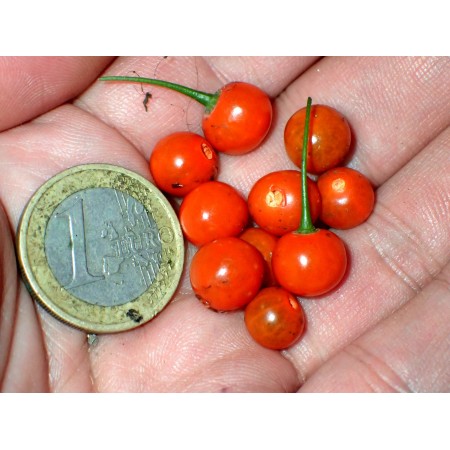






Hardy Chili (Capsicum flexuosum) is a deciduous shrub about 1-3 m (=3-10 ft) tall that produces mildly spicy (in the case of my plants, they are actually quite spicy), very sweet-tasting, small (about 7-10 mm), round, red fruits and black seeds. This very rare species of wild pepper is native to southern Brazil and the extreme northern part of neighboring Argentina and eastern Paraguay. It is incredibly cold and frost hardy - down to about 5-14 degrees F [= (-10)-(-15) degrees C] or even less under preferred conditions. Perhaps this shrub can also be grown in an open garden in Poland, thickly mulched - the above-ground part will freeze, but it should spring back from the roots (there is a caveat, however - if someone would like to try this, we do not guarantee success and we recommend planting a large plant in the garden in spring, one that has already overwintered at least one winter, e.g. in a cellar, so that it has time to settle in well and grow until autumn. We also advise thickly mulching the area around it, about 1-2 square meters. In our country, these peppers overwinter in an unheated greenhouse, with the roots covered with agrotextile and a mound of soil. This plant is very difficult to propagate from seeds. It is best to use the hormone - gibberellic acid - GA3 (2000 ppm for 24 hours) + chamomile tea to soak the seeds before sowing (or cover the seeds with a chemical fungicide instead of chamomile). The seeds germinate slowly and irregularly (sometimes after a few months from the sowing date). They should be sown very shallowly in well-drained, light soil and maintained at constant humidity (e.g., cover the pot with a clear foil) and warmth (you can place the pots on a radiator until sprouts appear if it's cold in the house; then place them on a windowsill). And you have to be patient. Small seedlings are very, very susceptible to fungal diseases. Larger plants (over about 10-12 cm = 4-5 inches tall) are much more resistant. Later, it is a very easy plant to grow. Once established, it is drought-resistant but prefers well-drained soil. A "cactus mix" is best for it if the plants are grown in pots. They should be fertilized regularly. The plant can also be easily propagated vegetatively through semi-hardwood, green cuttings (preferably with a "heel"), which root easily in pots. A sunny windowsill (in a mixture of large amounts of sand and peat soil – approximately 1:1). The literature often describes this species as self-incompatible, so at least two genetically different plants are needed to produce fruit. However, I've noticed that a single plant can occasionally produce fruit without pollination from another plant, both outdoors and indoors (including without bee pollination). However, to harvest a good harvest, at least two genetically different plants (developed from two seeds) and insects (pollinators) are needed. In this case, the plant produces very numerous fruits. This plant is sometimes used for crossbreeding with other chili peppers. It possesses valuable "frost-resistant" genes. The chromosome number of C. flexuosum is the same as that of cultivated chili pepper species (2n = 24). Perhaps in the future, its genes will produce frost-resistant, large-fruited chili peppers? A rarity. A pack of 30 fresh seeds. Seeds harvested in the fall of 2025 yr. and stored under appropriate conditions.
Data sheet